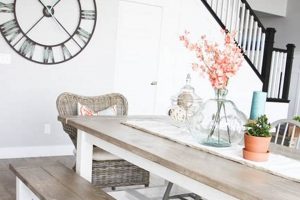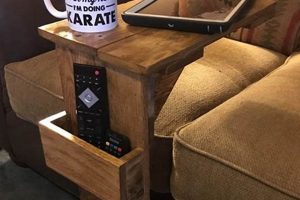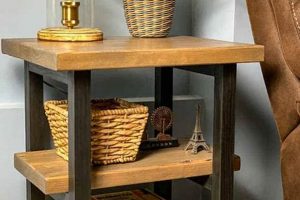A self-constructed plant preparation station is a work surface designed for gardening tasks such as transplanting seedlings, mixing soil, and potting plants. These structures offer a designated area for horticultural activities, aiding in organization and reducing mess within a home or garden. The design can range from simple repurposed tables to elaborate custom-built units with storage and integrated features.
The primary value of such a construction lies in its adaptability and cost-effectiveness. Individuals can tailor the dimensions, materials, and functionalities to meet specific needs and spatial constraints. This contrasts with commercially produced alternatives, which may not perfectly align with individual requirements or budget limitations. Historically, gardeners have utilized various surfaces for plant preparation; however, the dedicated, purpose-built station enhances efficiency and promotes ergonomic practices.
The following sections will explore diverse construction approaches, material selections, and design considerations relevant to creating a functional and aesthetically pleasing outdoor workspace. Detailed instructions, common challenges, and potential modifications will be presented to guide individuals through the process of building a customized solution.
Construction Recommendations
The subsequent recommendations address critical aspects of constructing a durable and efficient gardening workstation. These suggestions aim to optimize functionality and prolong the lifespan of the self-made structure.
Tip 1: Material Selection: Opt for weather-resistant materials like treated lumber, cedar, or composite decking. Untreated wood is susceptible to rot and insect infestation, significantly reducing the structure’s longevity. Consider salvaged materials to reduce costs, but ensure structural integrity before incorporation.
Tip 2: Ergonomic Height: Determine the optimal work surface height to minimize back strain. The ideal height typically falls between 36 and 40 inches, but individual preferences may vary. Prioritize comfort during prolonged use.
Tip 3: Drainage Considerations: Incorporate drainage holes in the work surface to prevent water accumulation. Stagnant water can damage the wood and create unsanitary conditions. Direct drainage away from the structure’s base to prevent soil erosion.
Tip 4: Soil Containment: Design a raised edge or lip around the work surface to contain soil and prevent spills. This feature simplifies cleanup and minimizes waste. A removable lip allows for easier sweeping and maintenance.
Tip 5: Adequate Storage: Integrate storage solutions, such as shelves, drawers, or hooks, to accommodate tools, pots, and soil amendments. Organized storage improves efficiency and prevents clutter. Prioritize accessibility of frequently used items.
Tip 6: Stable Base: Ensure a stable and level base to prevent wobbling or tipping. Uneven surfaces can compromise safety and hinder task performance. Adjustable feet or shims can compensate for minor irregularities.
Tip 7: Consider a Backsplash: A backsplash, even a simple one, can protect nearby walls or fences from dirt and moisture. This is particularly important if the station is placed against a structure. A removable or foldable backsplash adds versatility.
These guidelines aim to assist in the creation of a functional and enduring gardening workspace. Attention to detail during the construction process will contribute to a more enjoyable and efficient gardening experience.
The following sections will delve into advanced design concepts and customization options for truly personalized gardening solutions.
1. Ergonomic Height
Ergonomic height, with respect to a self-constructed plant preparation station, represents a critical design parameter influencing user comfort and physical well-being. The height of the work surface directly impacts posture and reach during gardening tasks such as potting, transplanting, and soil preparation. An improperly designed height can induce back strain, shoulder discomfort, and repetitive stress injuries. The selection of an appropriate height is thus not merely a matter of convenience but a fundamental factor in ensuring a safe and sustainable gardening practice.
The cause-and-effect relationship between work surface height and physical health is well-documented in ergonomic studies. A workstation that is too low necessitates excessive bending at the waist, leading to lower back pain. Conversely, a workstation that is too high requires elevated shoulders and strained neck muscles. The importance of customized height becomes apparent when considering diverse user statures and varying task requirements. For example, a taller individual requires a higher surface than a shorter individual, and detailed tasks like seed starting may benefit from a slightly lower surface for enhanced visibility and control. A practical example is observing the posture of gardeners using existing tables or surfaces; slouching or hunching indicates a mismatch between the work surface and the user’s ergonomic needs.
Therefore, determining the optimal height necessitates careful consideration of the user’s height, the types of gardening tasks performed, and the availability of adjustable features. Failure to address ergonomic height during the design and construction phase can negate the benefits of a dedicated plant preparation area, transforming a potentially helpful tool into a source of physical discomfort and potential injury. By prioritizing ergonomic principles, the self-constructed plant preparation station becomes a more sustainable and health-conscious addition to the gardening environment.
2. Durable Materials
The selection of durable materials for a self-constructed plant preparation station is fundamentally linked to its longevity and performance. The intended outdoor placement exposes the structure to environmental stressors such as moisture, sunlight, temperature fluctuations, and potential pest infestations. Material choices directly influence the station’s resistance to these elements. For example, using untreated softwood as the primary construction material inevitably leads to premature decay and structural instability, necessitating frequent repairs or eventual replacement. Conversely, employing naturally rot-resistant wood species, such as cedar or redwood, or utilizing treated lumber significantly extends the lifespan of the station. The direct consequence of selecting appropriate materials is a reduced need for maintenance and a prolonged period of functional utility.
The importance of durable materials extends beyond merely preventing structural failure. A stable and reliable work surface is crucial for safe and efficient gardening tasks. Warped or weakened components can compromise stability, increasing the risk of accidents or damage to plants and tools. Consider a scenario where a weakened leg support collapses under the weight of soil and pots, potentially causing injury and scattering debris. Furthermore, the aesthetic appeal of the station is directly impacted by the materials used. Durable materials, when properly maintained, retain their appearance over time, contributing to the overall visual harmony of the gardening space. Real-world examples include observing how untreated wooden garden structures succumb to weathering and decay within a few years, contrasted with the enduring quality of structures built with composite materials or treated lumber.
In summary, the prudent selection of durable materials is not simply a cost consideration but a critical investment in the long-term viability and functionality of the plant preparation station. Understanding the environmental factors that impact material integrity and prioritizing rot-resistant, weather-resistant, and structurally sound options is essential for creating a durable, safe, and aesthetically pleasing workspace. Overlooking this aspect can lead to premature failure, increased maintenance costs, and a diminished gardening experience. The practical significance of this understanding lies in enabling informed decision-making during the design and construction process, ensuring a lasting and valuable addition to the gardening environment.
3. Adequate Storage
Adequate storage, when integrated into a self-constructed plant preparation station, is a defining characteristic of a well-designed and functional workspace. Its presence dictates the efficiency and organization of gardening tasks, significantly impacting the overall user experience.
- Tool Organization and Accessibility
Dedicated storage solutions, such as drawers, shelves, or pegboards, facilitate the systematic organization of essential gardening tools. This ensures that trowels, pruners, hand forks, and other implements are readily accessible when needed, minimizing time spent searching for necessary equipment. A disorganized workspace, conversely, leads to frustration and decreased productivity. The presence of designated tool storage optimizes workflow and promotes a more efficient gardening process.
- Soil and Amendment Containment
Storage compartments designed for soil, compost, and other amendments are essential for maintaining a clean and organized workspace. Bins, shelves, or enclosed containers prevent spills and contamination, reducing the mess associated with potting and transplanting activities. The ability to store soil in a protected environment also helps maintain its moisture content and quality. Effective soil containment contributes to a more hygienic and productive gardening environment.
- Pot and Container Management
Shelving or designated storage areas for pots and containers of various sizes are crucial for managing plant propagation and transplanting. Organized storage allows for easy selection of appropriate containers based on plant needs. It also prevents clutter and potential damage to pots. The availability of dedicated pot storage enhances the efficiency of potting and transplanting operations, contributing to successful plant cultivation.
- Protection from the Elements
Enclosed storage compartments offer protection for sensitive materials and tools from inclement weather conditions. Storing fertilizers, seeds, and delicate tools in a sheltered environment prevents damage from rain, sunlight, or extreme temperatures. Protected storage contributes to the longevity of gardening supplies and ensures their readiness for use. The presence of weather-resistant storage enhances the overall practicality and usability of the plant preparation station.
The integration of these storage facets transforms a basic work surface into a comprehensive gardening hub. By addressing the need for organized tool management, soil containment, pot storage, and weather protection, the inclusion of adequate storage significantly enhances the functionality and value of the self-constructed plant preparation station.
4. Effective Drainage
Effective drainage is a critical design consideration for any self-constructed plant preparation station. Water accumulation, stemming from potting activities, rainfall, or irrigation runoff, can compromise the structural integrity of the unit and foster unsanitary conditions. Therefore, a properly implemented drainage system is paramount to the longevity and functionality of the workspace.
- Material Degradation Prevention
Water saturation accelerates the decomposition of wooden components, a common construction material for plant preparation stations. Standing water promotes fungal growth and insect infestation, leading to rot and structural weakening. Incorporating drainage channels, sloped surfaces, and permeable materials mitigates moisture retention, thereby extending the lifespan of the structure. Examples include using pressure-treated lumber or composite decking materials designed for exterior use, coupled with drainage holes strategically placed to allow water runoff.
- Soil Erosion Control
Uncontrolled water runoff can erode soil from the work surface or surrounding areas, creating a messy and inefficient workspace. Implementing drainage systems that direct water away from the station’s base and toward designated drainage zones prevents soil loss. This can involve integrating a collection basin or directing runoff onto a gravel bed for gradual infiltration. The result is a cleaner, more organized work environment and minimized soil wastage.
- Sanitary Conditions Maintenance
Standing water fosters the growth of algae, bacteria, and mold, posing potential health risks and creating an unpleasant working environment. Effective drainage eliminates breeding grounds for these organisms, promoting a more sanitary and hygienic space for plant propagation and handling. This is particularly important when working with soil and plant materials, which can harbor pathogens. Proper drainage helps prevent the spread of diseases and ensures a healthier gardening experience.
- Prevention of Tool Corrosion
Prolonged exposure to moisture can corrode metal tools and hardware stored on or near the plant preparation station. Effective drainage minimizes the risk of rust and deterioration, preserving the condition and functionality of gardening implements. This can involve providing a sheltered storage area with adequate ventilation or applying rust-resistant coatings to metal components. The consequence is a longer lifespan for tools and reduced replacement costs.
The implementation of effective drainage strategies, therefore, transcends mere aesthetic considerations, representing a fundamental design principle that directly impacts the durability, hygiene, and functionality of a self-constructed plant preparation station. A well-drained workspace ensures a more sustainable, efficient, and enjoyable gardening experience.
5. Stable Structure
The structural stability of a self-constructed plant preparation station is paramount to its functionality, safety, and longevity. A structurally unsound unit presents significant hazards, compromises usability, and shortens the lifespan of the construction. Therefore, the design and execution of a stable framework are essential considerations during the creation of such a gardening workstation.
- Load-Bearing Capacity
A stable structure must possess the capacity to bear the anticipated weight of soil, pots, tools, and other materials placed upon it. Inadequate load-bearing capabilities can result in sagging, warping, or catastrophic failure. The choice of materials, joint construction, and support systems directly influence this capacity. Real-world examples include reinforcing table legs with cross braces, selecting appropriately sized lumber for the tabletop, and distributing weight evenly across the surface. Improper load distribution or insufficient structural support jeopardizes the entire assembly.
- Resistance to Tipping and Movement
A stable structure must resist unintentional tipping or movement, particularly on uneven surfaces or in windy conditions. A wide base, low center of gravity, and secure footing contribute to this resistance. The addition of leveling feet or ground anchors can further enhance stability. Instability can lead to spillage of materials, damage to plants, and potential injury to the user. An example of a preventative measure would be widening the base of the legs and using heavier materials on the bottom to lower the center of gravity.
- Joint Integrity and Connection Strength
The strength and integrity of joints and connections are critical to overall structural stability. Weak or poorly executed joints can compromise the entire framework, leading to instability and eventual failure. Proper joinery techniques, such as mortise and tenon, dovetail, or secure screw attachments, are essential. Furthermore, the use of high-quality fasteners and adhesives contributes to joint strength. The selection of appropriate joinery methods depends on the materials used and the anticipated stresses on the structure. A poorly constructed joint can lead to racking, wobbling, and eventual collapse.
- Material Quality and Dimensional Stability
The quality and dimensional stability of the construction materials directly impact the long-term structural integrity of the potting station. Materials that are prone to warping, shrinking, or swelling can compromise joint integrity and overall stability. Selecting materials that are resistant to these changes, such as kiln-dried lumber or composite materials, is crucial. Furthermore, proper seasoning and storage of lumber before construction can minimize dimensional changes. Instability in the materials can lead to warping, cracking, and eventual structural failure.
The factors detailed above are critical to a functional DIY potting table. A failure to address even one of these will result in a finished structure that will not last, is difficult to use, and is potentially dangerous. Therefore, the structural stability of a self-constructed plant preparation station is not merely an aesthetic consideration but a fundamental requirement for safe, efficient, and sustainable gardening practices.
Frequently Asked Questions
This section addresses common inquiries and misconceptions regarding the design, construction, and maintenance of do-it-yourself gardening workstations, providing clarification and practical guidance.
Question 1: What constitutes the optimal work surface height for a self-constructed potting station?
The ideal work surface height is determined by the user’s stature and preferred working posture. A general guideline recommends a height that allows the user to work without excessive bending or reaching, typically ranging from 36 to 40 inches. Individual ergonomic assessments are advised to optimize comfort and prevent strain.
Question 2: What are the most durable and cost-effective materials for building a long-lasting outdoor potting table?
Weather-resistant materials such as treated lumber, cedar, or composite decking offer excellent durability. While cedar and composite materials exhibit inherent resistance to rot and insects, treated lumber provides a cost-effective alternative when properly sealed and maintained. Salvaged materials can further reduce costs, provided they maintain structural integrity.
Question 3: How can adequate drainage be effectively integrated into a do-it-yourself plant preparation station?
Effective drainage involves incorporating drainage holes into the work surface to prevent water accumulation. Sloping the surface slightly towards the drainage points facilitates runoff. A collection basin or gravel bed beneath the station can manage discharged water and prevent soil erosion.
Question 4: What strategies can be employed to ensure the structural stability of a self-built gardening workstation?
Structural stability is achieved through robust joint construction, appropriate material selection, and adequate support systems. Reinforcing table legs with cross braces, using high-quality fasteners, and ensuring a level base are essential. A wide base and low center of gravity enhance resistance to tipping.
Question 5: What considerations are paramount when designing integrated storage solutions for a potting table?
Integrated storage should prioritize accessibility, organization, and protection of stored items. Shelves, drawers, and hooks can accommodate tools, pots, and soil amendments. Enclosed compartments offer protection from the elements, ensuring the longevity of gardening supplies.
Question 6: How does one properly maintain a self-constructed outdoor potting station to maximize its lifespan?
Regular maintenance involves cleaning the work surface, inspecting for signs of damage, and reapplying protective coatings as needed. Periodic sealing or staining of wooden components helps prevent water damage and insect infestation. Promptly addressing any structural issues prevents further deterioration.
These FAQs serve as a guide for addressing critical aspects of creating a functional and enduring gardening workspace. Understanding these principles contributes to a more enjoyable and efficient gardening experience.
The following section will explore advanced design concepts and customization options for truly personalized gardening solutions.
Conclusion
The preceding exploration of the self-constructed plant preparation station has illuminated critical design, material, and functional considerations. Effective drainage, durable materials, adequate storage, ergonomic design and stable construction are all paramount elements necessary for a safe, functional, and long-lasting outdoor workspace. Understanding and implementing these principles ensures that a self-built unit provides utility and contributes positively to the gardening endeavor.
The creation of such a structure, when thoughtfully executed, represents a commitment to efficient and sustainable gardening practices. A well-conceived and diligently constructed plant preparation area provides benefits exceeding the initial investment of time and resources, therefore individuals should approach the project with careful planning and meticulous execution.


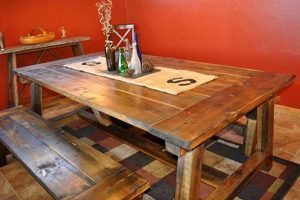
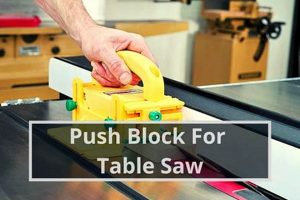
![Build a Safe DIY Table Saw Push Stick [Guide] The DIY Hub: Creative Crafts, Repairs & Life Hacks Build a Safe DIY Table Saw Push Stick [Guide] | The DIY Hub: Creative Crafts, Repairs & Life Hacks](https://craftingdiycenter.com/wp-content/uploads/2025/07/th-4323-300x200.jpg)
